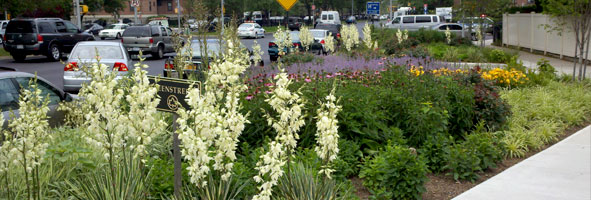Green Infrastructure

Green Infrastructure is a citywide system of engineered landscapes that transform unused impervious areas into vibrant and pervious green space. Through inter-agency partnerships, we build spaces that provide a multitude of social and environmental benefits; the quality and performance of these spaces are enhanced through our ongoing research work.
History
Launched in 1996, the Greenstreets program began as a partnership between the NYC Parks and the New York City Department of Transportation (DOT). The program was created to change unused road areas into green spaces that beautify neighborhoods, improve air quality, reduce air temperatures, and calm traffic. Since its beginning, over 2,500 Greenstreets have been built citywide.
What we do
In 2010, the Greenstreets program became the Green Infrastructure Unit, expanding our focus to active stormwater capture. The New York City Department of Environmental Protection (DEP) has partnered with the Green Infrastructure Program to build cost-effective stormwater capture to help reach its water quality goals. Because of our recent funding source, new greenstreets will be constructed in DEP-designated priority sewersheds, where the Combined Sewer Overflow (CSO) effect is most significant. Learn more about DEP and their Green Infrastructure Plan
Determining Green Infrastructure Locations
We work with DEP to determine Stormwater Greenstreet (SGS) and Right-of-Way Bioswale (ROWB) locations according to hydraulic analysis, site survey, existing conditions, and the NYC Department of Transportation (DOT) traffic safety standards. We also require soil borings and soil permeability tests at each location to determine whether the subsoil is suitable to infiltrate stormwater.
At this stage of the Program, we are not processing requests and we cannot provide exact locations of all proposed ROWBs. However, once a construction schedule is in place, it's our procedure to notify neighborhoods of upcoming project locations by sending postcards and by reaching out to the local Community Boards.
We will still build traditional greenstreets in any community, but only if it comes with independent and full funding. Otherwise, any greenstreet request will now be rated on its location within a priority sewershed, its capacity to capture stormwater, its alignment with other agency infrastructural improvements, its complexity of maintenance, and its capacity to link separated green spaces into a greater whole, otherwise known as ecological connectivity. In addition, any request that comes with a maintenance commitment will be rated with a higher score.
Resources
Visit the New York City Department of Environmental Protection's Green Infrastructure page to learn more about the citywide effort to better manage stormwater through green infrastructure, like rain gardens. From this page, you can find out if your neighborhood is one of DEP’s Priority Areas, get more information about upcoming projects, and view the Right of Way Bioswale standard designs.